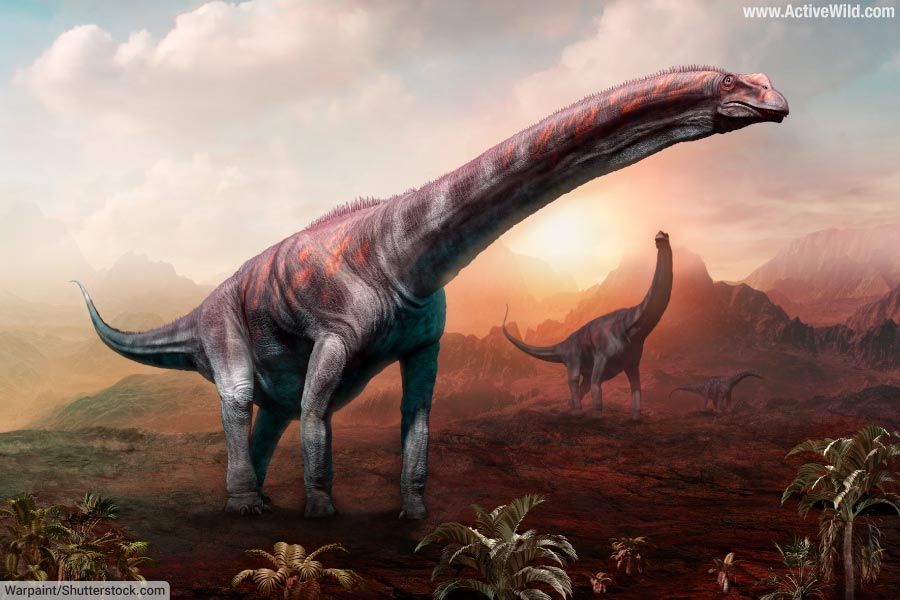Argentinosaurus, whose name means “Argentine lizard”, is one of the largest dinosaurs ever discovered. A member of a group of huge sauropods known as Titanosaurs, Argentinosaurus roamed South America during the Late Cretaceous period.
Page Index
Argentinosaurus Facts
- Type of Dinosaur: Sauropod
- Diet: Herbivore
- Continent(s) Found: South America
- Length: Approximately 30–35 meters (98–115 feet)
- Height: Estimated to be around 7 meters (23 feet) at the shoulder
- Weight: Estimates range from 50 to 100 metric tons (55 to 110 short tons)
- Period: Late Cretaceous (approximately 94-97 million years ago)
What Did Argentinosaurus Look Like?


Argentinosaurus was a colossal sauropod dinosaur, known chiefly for its massive size. Measuring approximately 30 to 35 meters (98 to 115 feet) in length, Argentinosaurus was among the longest dinosaurs that ever roamed the Earth. Its height at the shoulder was around 7 meters (23 feet), giving it a towering presence in its environment.
You can find out more about the different types of dinosaurs on this page: Types Of Dinosaurs
To put the immense size of Argentinosaurus into perspective, its length would be equivalent to approximately 2.5 to 2.9 standard city buses placed end to end. Its height at the shoulders would have been as high as a two-story house!
In terms of weight, estimates suggest that Argentinosaurus likely weighed between 50 and 100 metric tons (55 to 110 short tons).
That’s around the weight of 8 or 9 city buses!
The dinosaur’s immense weight was supported by its four thick, pillar-like legs, which were adapted to bear the enormous mass of its body. These legs were robust and columnar – like those of an elephant – but far more massive, ensuring stability and support.
The body of Argentinosaurus was characterized by a long neck and tail, with a massive, barrel-shaped torso. The elongated neck allowed it to reach high vegetation, essential for its herbivorous diet, while the long, whip-like tail helped with balance and might have served as a defensive tool.
The skin of Argentinosaurus, while not definitively known, is believed to have been rough and scaly, with possible variations in color and patterns for camouflage or thermoregulation.
The head of Argentinosaurus was relatively small in comparison to its enormous body, equipped with peg-like teeth suitable for stripping leaves off plants.
What Type Of Dinosaur Was Argentinosaurus?


Argentinosaurus was a type of sauropod dinosaur. Sauropods were characterized by their large size, long necks, long tails, and four thick, pillar-like legs.
Argentinosaurus belonged to a group of sauropods known as Titanosauria. The titanosaurs were a diverse group of sauropod dinosaurs that lived from the Late Jurassic to the end of the Cretaceous period.
Titanosaurs were herbivorous and included some of the heaviest and longest dinosaurs known, such as Argentinosaurus and Patagotitan.
The fossilized remains of titanosaurs have been found on every continent, indicating their widespread distribution and adaptation to various environments.
Where Did Argentinosaurus Live?
Argentinosaurus lived in what is now the Patagonia region of Argentina, in South America.
This huge dinosaur was first discovered in Argentina in 1987. Its fossil remains were found in the Huincul Formation in the Neuquén Province of Patagonia. The discovery was made by a local farmer, who stumbled upon the bones, which were later studied and described by paleontologists.
The type species, Argentinosaurus huinculensis, was formally described in 1993 by paleontologists José F. Bonaparte and Rodolfo Coria. The discovery included vertebrae and parts of the pelvis, which provided significant insights into the enormous size and characteristics of this sauropod dinosaur.
The name Argentinosaurus means “Argentine Lizard”. The specific part of the dinosaur’s name (huinculensis), refers to the area in which it was found.
When Did Argentinosaurus Live?
Argentinosaurus lived during the Late Cretaceous period, approximately 94 to 97 million years ago.
You can find out more about the Cretaceous and other periods of the Mesazoic Era on this page: Dinosaur Periods
Earth During The Cretaceous Period
During the Late Cretaceous period, South America had a warm and semi-arid climate with vast floodplains, river systems, and deltas. These landscapes were covered with forests of conifers, ferns, and other prehistoric plants, providing ample vegetation to support large herbivorous dinosaurs like Argentinosaurus.
The region was part of the supercontinent Gondwana and was home to a diverse dinosaur community, including other titanosaurs, theropods, and smaller herbivores. The ecosystem also included early mammals, reptiles, and birds.
What Other Dinosaurs Did Argentinosaurus Live With?
Other dinosaurs found in the Huincul Formation (the site of Argentinosaurus’ discovery) include:
Mapusaurus: a large carnivorous theropod dinosaur from the Late Cretaceous period, closely related to Giganotosaurus, that lived in what is now Argentina and likely hunted in packs. It possibly preyed on large herbivores such as Argentinosaurus.
Skorpiovenator: A mid-sized theropod dinosaur, known for its distinctive skull and teeth. A near-complete skeleton found in the Huincul Formation makes it one of the best-known abelisaurids.
Discover More With Active Wild
Visit our main dinosaur page for dinosaur facts, pictures, in-depth information and lists: Dinosaurs – The Complete Guide
You can see more Cretaceous Period dinosaurs on this page: Cretaceous Period Dinosaurs

